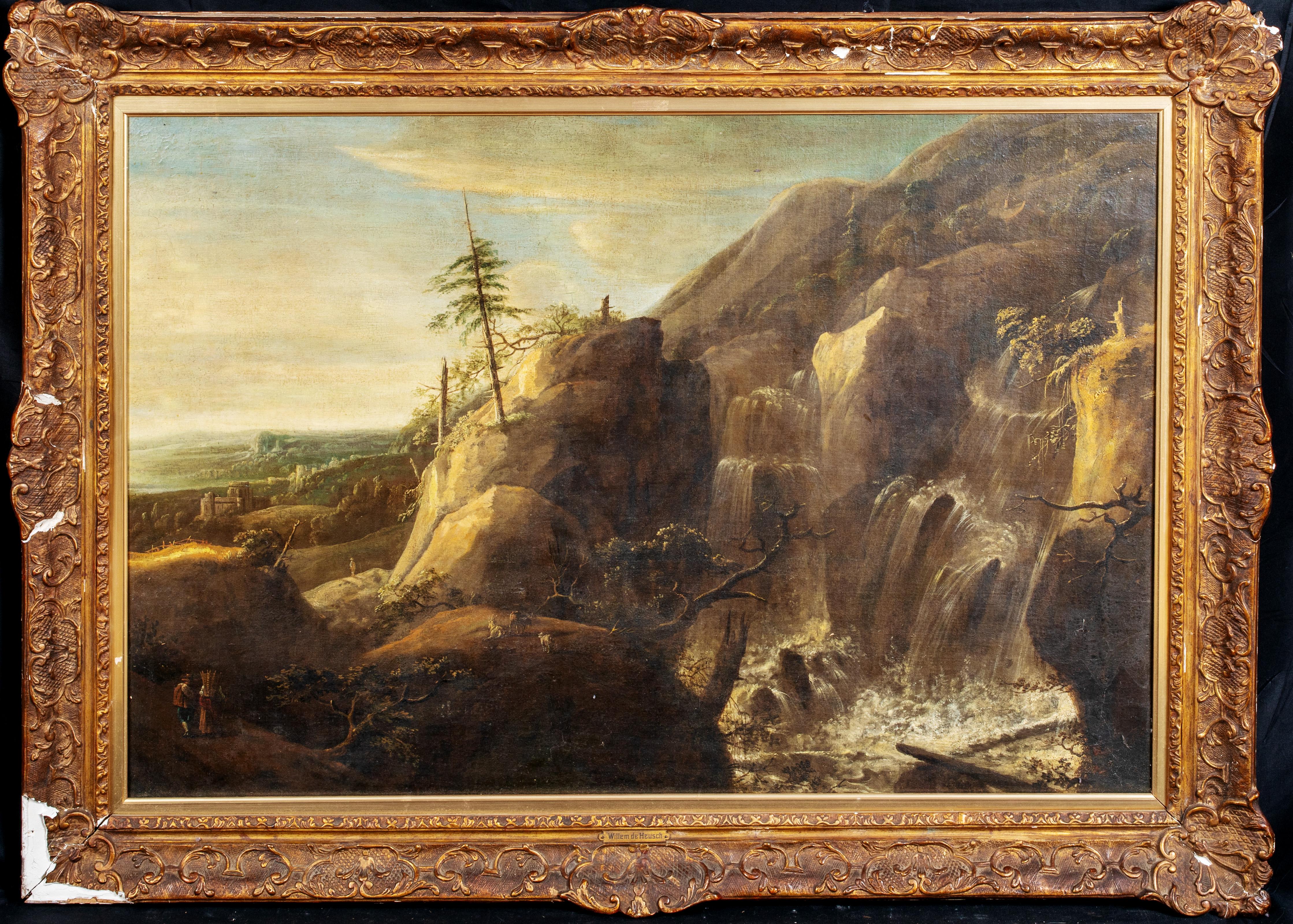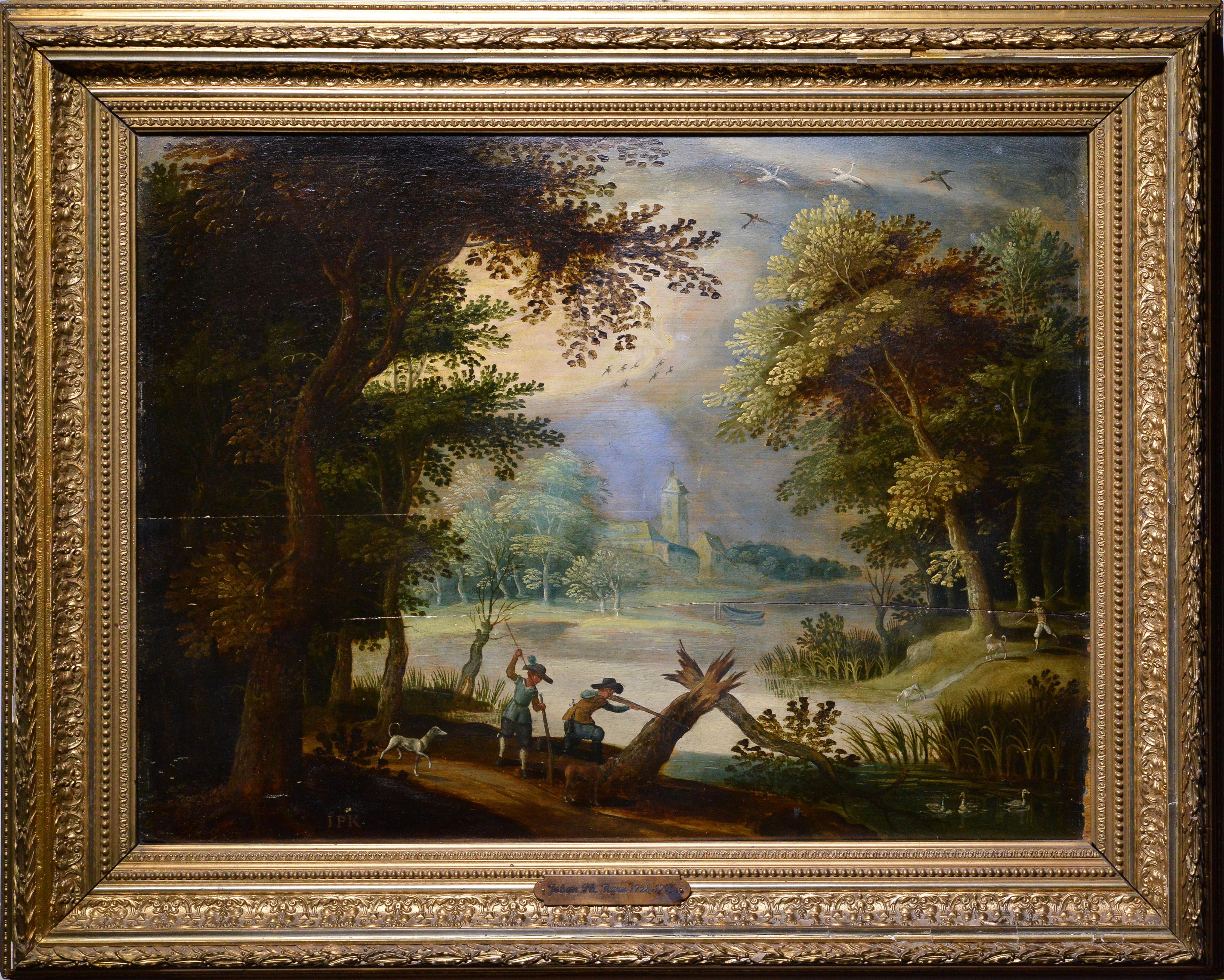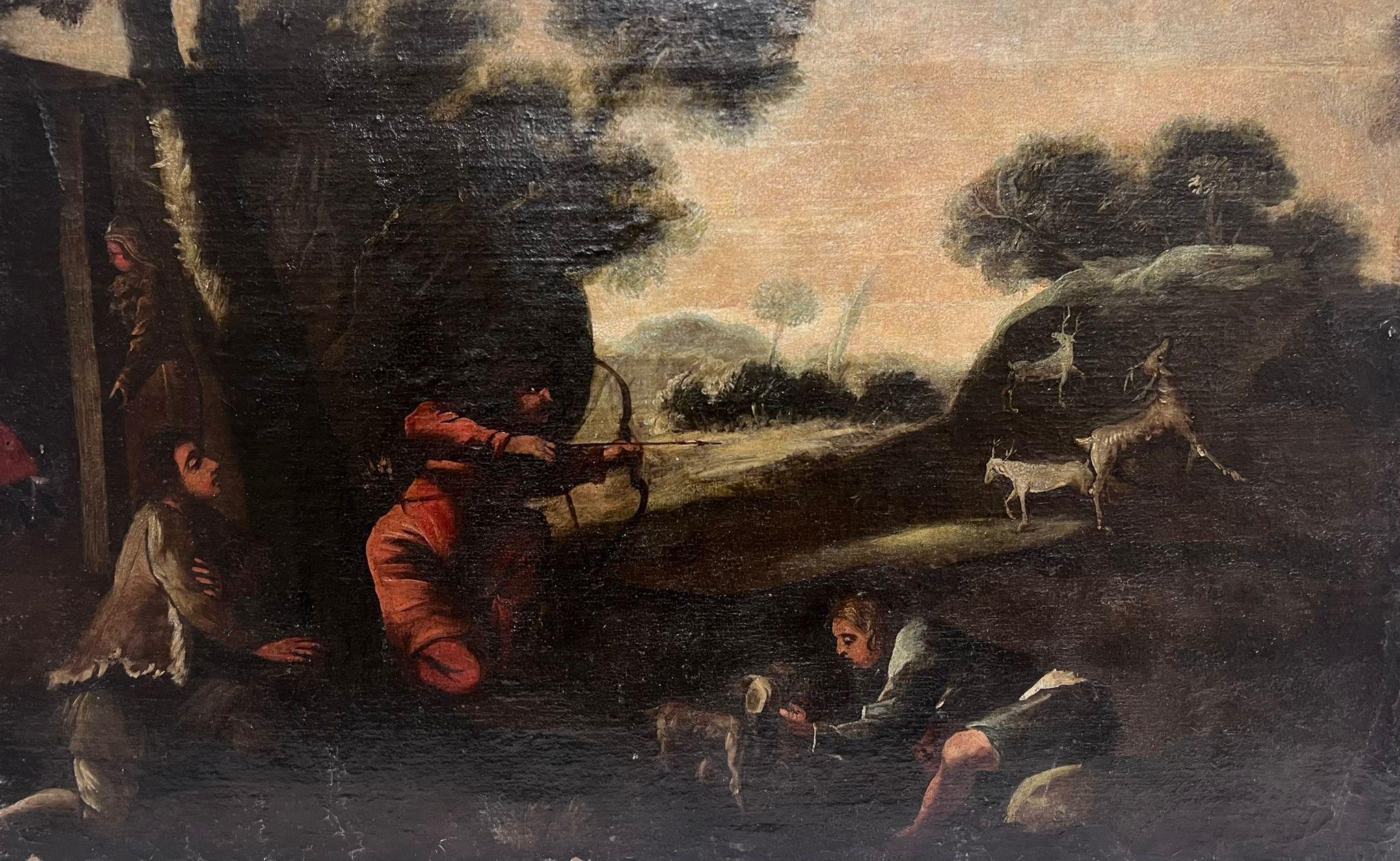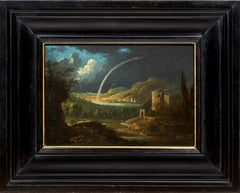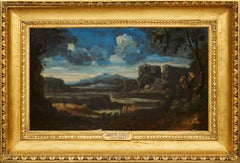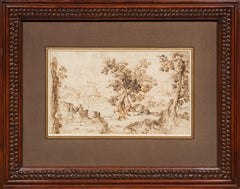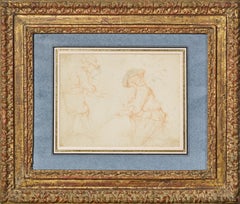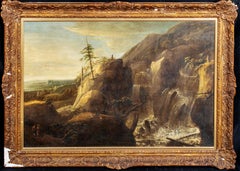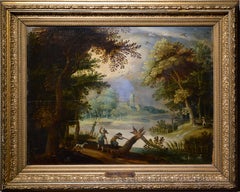Items Similar to Stag Hunting in the Vicinity of Nuremberg by a German Artist Peter von Bemmel
Want more images or videos?
Request additional images or videos from the seller
1 of 9
Peter von BemmelStag Hunting in the Vicinity of Nuremberg by a German Artist Peter von BemmelCirca 1720-1730
Circa 1720-1730
$6,623.02
£4,900.21
€5,500
CA$9,157.51
A$10,053.80
CHF 5,245.09
MX$121,665.03
NOK 65,739.08
SEK 61,943.49
DKK 41,877.15
About the Item
This small landscape shows a hunting scene: two riders are chasing a stag with their dogs at the edge of a forest. Signed by Peter von Bemmel, it is typical of the production of this artist, in the great tradition of Dutch landscapes.
1. Peter von Bemmel, a landscape painter in the Dutch tradition
Peter von Bemmel was born in Nuremberg in 1685 into an artistic family. His father, the Dutch-born painter Willem van Bemmel (1630 - 1708), was born in Utrecht and trained in the studio of Herman Saftleven the Younger (1609 - 1685). After a ten-year sojourn in Italy, he settled in Nuremberg in 1662 and specialised in Italian-style landscapes. Peter's elder brother Johan Georg von Bemmel was also a painter, as were his two sons Christoph and Johann Christoph.
Peter von Bemmel was a landscape painter and engraver. His work, which is still very much influenced by his father's productions, is well represented in the Herzog Anton Ulrich Museum in Braunschweig and in the museums of his home town, Nuremberg.
2. Description of the artwork
Two riders and their dogs are chasing a stag in a wooded landscape, on the banks of a river that can be seen in the foreground. While the rider on the left, wearing a red jacket, is perfectly legible, as the paint has become transparent over time, the three dogs, the rider on the right and the stag blend into the brown tones of the undergrowth in which this hunt is taking place.
A village, lit in beautiful golden late afternoon light, can be seen in the blueish background whose clarity contrasts with the dark masses formed by the trees in the foreground.
The Municipal Museums of Nuremberg house a related work depicting a hunt in ponds near the city of Nuremberg whose silhouette appears in the background of the composition. This painting has a number of characteristic features that can be found in our artwork: the dark treatment of the forest, which is only illuminated by a few light spots along the trees, the central presence of water, and a bluish urban landscape in the background.
The afore mentioned composition is dated between 1730-1750. We would like to propose an earlier date for our painting (ca. 1720-1730) because it seems to us that the influence of Willem van Bemmel, the artist's father, is more noticeable in this composition.
We have chosen to present this painting in a marvellous Italian frame from the early 18th century. The brightness of the carved and gilded wood enhances the rather dark tones of the woods.
Main bibliographic source :
Wolf Eiermann - Willem van Bemmel (1630 - 1708) - Petersberg 2007
- Creator:Peter von Bemmel (1685 - 1754, German)
- Creation Year:Circa 1720-1730
- Dimensions:Height: 10.63 in (27 cm)Width: 13.39 in (34 cm)
- Medium:
- Movement & Style:
- Period:1720-1729
- Condition:14 x 20.7 cm (27 x 34 cm framed) Signed lower left "P v Bemmel".
- Gallery Location:PARIS, FR
- Reference Number:1stDibs: LU156828274632
About the Seller
5.0
Vetted Professional Seller
Every seller passes strict standards for authenticity and reliability
Established in 2020
1stDibs seller since 2021
10 sales on 1stDibs
- ShippingRetrieving quote...Shipping from: PARIS, France
- Return Policy
Authenticity Guarantee
In the unlikely event there’s an issue with an item’s authenticity, contact us within 1 year for a full refund. DetailsMoney-Back Guarantee
If your item is not as described, is damaged in transit, or does not arrive, contact us within 7 days for a full refund. Details24-Hour Cancellation
You have a 24-hour grace period in which to reconsider your purchase, with no questions asked.Vetted Professional Sellers
Our world-class sellers must adhere to strict standards for service and quality, maintaining the integrity of our listings.Price-Match Guarantee
If you find that a seller listed the same item for a lower price elsewhere, we’ll match it.Trusted Global Delivery
Our best-in-class carrier network provides specialized shipping options worldwide, including custom delivery.More From This Seller
View AllRiver Landscape with Shepherds and Architecture, a painting by Jan van Bunnik
By Jan van Bunnik
Located in PARIS, FR
This painting has been the subject of a study by the art historian Fabrizio Dassie (available on request), confirming its inclusion in Jan van Bunnik’s corpus.
In this painting, Ja...
Category
Late 17th Century Old Masters Landscape Paintings
Materials
Copper
Italian Landscape with Jack Players, a painting by Gaspard Dughet (1615 - 1675)
By Gaspard Dughet
Located in PARIS, FR
Here Gaspard Dughet offers us an idyllic vision of the Roman countryside. The stages follow one another in a perfectly structured composition, revealing here a lake, there travellers walking along, gradually leading our eye to the blue horizon. But behind its classical composition, this landscape is particularly interesting because of three anthropomorphic details that the artist has hidden, opening the way to a radically different interpretation...
1. Gaspard Dughet, a landscape artist in the light of Poussin
Gaspard Dughet was born on June 4th, 1615 in Rome where his father, of French origin, was a pastry cook. He was probably named Gaspard in honour of his godfather Baron Gaspard de Morant, who was, or may have been, his father's employer. His older sister Jeanne married the painter Nicolas Poussin (1594 - 1655) on September 1st, 1630. The young Gaspard was apprenticed with his brother-in-law at the beginning of 1631, which led his entourage to name him Gaspard Poussin. The first preserved works of the painter date from the years 1633-1634 and were painted in Poussin’s studio.
Around 1635, Gaspard Dughet became emancipated and began to frequent the Bamboccianti circle. In 1636, he became friends with the painter Jean Miel (1599 - 1656), but also with Pier Francesco Mola (1612 - 1666) and Pietro da Cortona (1596 - 1669).
This was also the time of his first trips throughout Italy. The painter, although of French origin, appears never to have visited France. In 1646 he settled permanently in Rome. A recognized painter with a solid book of orders, he remained faithful to landscape painting throughout his life, alternating between cabinet paintings and large decorative commissions, using both oil and fresco.
Nailed to his bed by rheumatic fever at the age of 58, he died on May 25, 1675.
2. Discovering an idealized landscape
Beyond a relatively dark foreground that takes us into the landscape, we discover a vast bluish horizon: a plateau surrounded by deep ravines advances to the right, overhanging an expanse of water that sparkles below. A road winds through a mountainous mass as if leading us to the fortress that crowns it; another town appears in the distance at the foot of three conical mountains.
The composition is rigorous, mineral, and structured by geometric volumes. The various stages in the landscape lead one to the next attracting the eye towards the horizon located in the middle of the canvas. The general impression is that of a welcoming and serene nature.
In many places the paint layer has shrunk, or become transparent, revealing the dark red preparation with which the canvas was covered and accentuating the contrasts.
Human presence is limited to three jack players, leaning against a mound in the foreground. Their long garments, which may evoke Roman togas, contribute to the timelessness of the scene.
Close examination of the canvas reveals two other travellers on the path winding between the rocks. Made tiny by the distance, their introduction in the middle register, typical of Dughet's art, lengthens the perspective.
While it is difficult to date the work of a painter who devoted his entire life to the representation of landscapes, it is certain that this painting is a work from his later years. The trees that occupied the foreground of his youthful compositions have been relegated to the sides, a stretch of water separates us from the arid mountains counterbalanced by two trees represented on the opposite bank. The introduction of this stretch of water in the middle of the landscape betrays the influence of the Bolognese and in particular of the Dominiquin (1581 - 1641)
A number of similarities with a drawing in the British Museum might suggest a date around 1656-1657, since, according to Marie-Nicole Boisclair , it has been compared with the Prado's Landscape with the Repentant Magdalene, painted at that period.
3. Three amazing anthropomorphic details
While some late Renaissance landscapes offer a radical double reading, allowing one to see both a face or a human body behind the representation of a landscape, it seems interesting to us to hypothesize that Gaspard Dughet had fun here by slipping in a few details that, taken in isolation, evoke human or animal figures.
We will give three examples, looking closely at a cloud, the trunk of a broken tree and the top of a cliff.
The main cloud could thus evoke a Christ-like face or that of an antique god...
Category
1650s Old Masters Landscape Paintings
Materials
Oil
Rocky Landscape with Trees and Temple Ruins a drawing by Giulio Parigi (ca 1615)
Located in PARIS, FR
This Rocky Landscape with Trees and the Ruins of a Temple is a drawing by Giulio Parigi, an eclectic and prolific artist of the Medici court. An engraver, architect, furniture and je...
Category
1610s Old Masters Landscape Drawings and Watercolors
Materials
Ink, Laid Paper, Pen
Study for a Hunting Scene, a red chalk sketch attributed to Karel du Jardin
Located in PARIS, FR
We would like to thank Carolina Trupiano Kowalczyk for suggesting this attribution to Karel du Jardin after direct examination of the artwork. Her study of the drawing (in Italian), ...
Category
1650s Old Masters Figurative Drawings and Watercolors
Materials
Chalk, Ink, Laid Paper
Diana and Actaeon, a Mannerist painting after Joseph Heintz the Elder
Located in PARIS, FR
This painting seduced us with its rich colors. Depicting Diana and her companions surprised by Actaeon, it was inspired by an engraving by Aegidius Sadeler II after a painting by Jos...
Category
17th Century Old Masters Nude Paintings
Materials
Oil, Wood Panel
Macbeth and the Three Witches a Painting on Panel by Francesco Zuccarelli
By Francesco Zuccarelli
Located in PARIS, FR
This painting, created during Zuccarelli's stay in England, represents the decisive moment when Macbeth, together with Banquo, meets the three witches who announce that he will be Ki...
Category
1760s Old Masters Landscape Paintings
Materials
Oil, Wood Panel
You May Also Like
Flemish Early 17th Century Old Master Oil on Panel Painting Hunting Scene 1620
Located in Portland, OR
A highly important Flemish Old Master oil painting by Peter Van Lint (1609-1690), titled "Preparing for the Hunt", the painting is dated & signed by the artist, 1620. The painting wa...
Category
1620s Old Masters Landscape Paintings
Materials
Oil, Panel
Dutch or Flemish Landscape with Figures & Animals
Located in Milford, NH
A beautifully detailed late 17th or early 18th century Dutch or Flemish landscape with cows grazing in the water, goats, dogs, and other animals near the water’s edge, under the watchful eye of the herdsmen, on a backdrop of rolling hills and trees. Oil on wood panel, unsigned, and housed in a Rudolph...
Category
Late 17th Century Flemish School Landscape Paintings
Materials
Oil, Wood Panel
The Hunting Party, 17th Century - School of Simon KICK (1603-1652)
Located in Blackwater, GB
The Hunting Party, 17th Century
School of Simon KICK (1603-1652)
Huge 17th Century Dutch Old Master interior of a hunting party after the hunt, oil on canvas. Excellent quality and condition that would signifcantly enhance with a light clean. Presented in an antique gilt frame. Exceptionally detailed and early interior hunting portrait...
Category
17th Century Landscape Paintings
Materials
Canvas, Oil
Animal scene Duck hunting with dogs 18th century Swedish Master by Philip Korn
Located in Stockholm, SE
Monogrammed lower left: Johan Philip Korn (1728 - 1796), was a Swedish painter. A beautiful landscape, with a backwater in which carefree ducks swim, hunters and their dogs in passion, in the background you can see a city with a bell tower. Old masters have been depicting animals in their paintings since the Renaissance. In those days, hunting scenes were popular - there is always a share of emotional participation in them. Here it is necessary to understand that in previous centuries people looked at hunting as a means of obtaining food, therefore naturalism dominates in the painting of the old masters. Old oil painting on wooden panel, in a non-original frame of the 19th century.
Size app.: 49 x 64 cm (roughly 19.3 x 25.2 in) and nice golden gesso frame ca 65.5 x 81.5 cm (roughly 25.8 x 32.1 in). Very Good condition, age wear, cracks on a wooden board, minor losses, retouches, cleared and conserved. Please study good resolution images for overall cosmetic condition. In person actual painting may appear darker or brighter than in our pictures, strictly depending on sufficient light in your environment. Weight of app. 6.4 kg is going to measure some 10 kg volume weight packed for shipment.
Johan Philip Korn first began his career as a decorative painter. He was a student of artist Johan Sevenbom (1721-1784). After further studies he changed to landscape painting in the Rococo style of French artist François Boucher (1703–1770) and often after Dutch copper engravings. In 1759, Korn became master of the Stockholm...
Category
18th Century Realist Landscape Paintings
Materials
Wood, Oil
17th Century Baroque Old Master Oil Painting Stag Hunting Party in Landscape
By Philipp Peter Roos (Rosa di Tivoli)
Located in Cirencester, Gloucestershire
The Hunting Party
German/ Italian School
circle of Philipp Peter Roos (German 1655-1706)
oil on canvas, unframed
19 x 31 inches
provenance: private collection, France
condition: good...
Category
Late 17th Century Baroque Figurative Paintings
Materials
Oil, Canvas
Herding cattle through a wooded river landscape
Located in Stoke, Hampshire
James Stark (1794-1859)
Herding cattle through a wooded river landscape
Oil on canvas
Canvas Size 18 x 24 in
Framed Size 23 x 29 in
James Stark (1794-1859): A Pioneer in Landscape P...
Category
18th Century Old Masters Landscape Paintings
Materials
Oil
$6,824 Sale Price
37% Off
More Ways To Browse
German Hunting
Stag Hunting
German Stag
Oil Paintings Of Stags
Tropical Island Art
Vintage Christmas Village
Vintage Hay Wagon
Vintage Pastel Landscape
William Ship Painting
Wolf Kahn Pastels
Wyoming Oil Painting
Yvette Bossiere
1910s Oil Painting
Adriaen Van De Velde
Agnes Reeve
Aldro Hibbard Thompson
Alfred De Breanski Snr
Alicia Dubnyckyj

